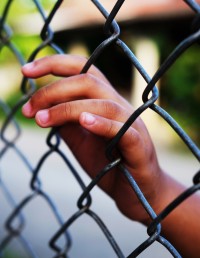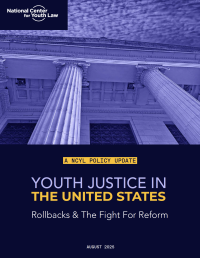California Law Gives Youth Sentenced to Life Without Parole Another Chance
By Michael Harris
In a key policy shift that could spur other states to change their sentencing practices, California enacted SB 9 on September 30, 2012. The new law gives juvenile offenders sentenced to life without the possibility of parole the opportunity to seek a hearing to reduce their sentences to 25 years to life. SB 9 was co-sponsored by NCYL and the Children’s Defense Fund. Its enactment concluded a several-year-long campaign to get the legislation passed. SB 9 represents a significant, though not complete, victory for the movement fighting for more sane and less punitive sentencing of youth.
Some Context: The Explosion in Incarceration
This nation currently imprisons about 2.2 million people, more by far than any other country.1 The number of people incarcerated in the US has grown by 500 percent over the last 30 years (See chart below). China, which has a population four times that of the US, is a distant second, with 1.6 million people behind bars.2 The US has 5 percent of the world's inhabitants, but 25 percent of the world's imprisoned population.3
Not surprisingly, the US also has the highest incarceration rate, with 730 people behind bars for every 100,000 in population.iv The only other major industrialized nation that comes close is Russia, with 502 prisoners for every 100,000 people.v The median for all nations is about 125, roughly one-sixth of the American rate.
This is a relatively recent phenomenon. Up until the 1970s, the US had a much more restrained approach to incarceration (See chart). Since that time, the US has been locking people up in ever greater numbers.
Juvenile Incarceration
This nation’s juvenile justice system was created to help rehabilitate young offenders. Over the past several decades, that system has veered, like its adult counterpart, in a punitive direction. Legislation has been enacted that mandates much longer sentences for youth convicted of certain offenses. And since 1992, a total of 45 states have passed laws that allow youth to be tried as adults.6
Much of the shift toward a punitive approach is attributable to two major factors. First, there were widely publicized predictions in the 1990s of an impending tidal wave of juvenile “superpredators” who would commit terrible crimes without remorse and who would thus not be amenable to rehabilitation. John Dilulio, a professor of Political Science at Princeton University, helped propagate this myth. Based on his predictions and powers of persuasion, many states moved away from the rehabilitative model.
Crucially, Dilulio’s predictions failed to come true. Juvenile criminal activity peaked in the mid-1990s and has declined steadily ever since. Juvenile crime rates are now the lowest they have been in decades7 (See chart below).
The second major factor in the punitive turn was the extensive media coverage of the Columbine High School shootings in 1999. Media reports fueled a growing sense that a harsher response to juvenile crime was necessary.8
Today, about 2,500 people in the US are serving life in prison without the possibility of parole (LWOP) for crimes committed while under the age of 18.9 An estimated 309 of them are incarcerated in California.10 The US is the only country currently sentencing children to LWOP. According to Amnesty International, several countries have the practice on their books; however, the group knows of no cases outside the US in which such a sentence has been imposed in recent years.11
Racial disparities are a chronic feature of LWOP sentencing, as they are in all other stages of the juvenile and criminal justice systems. One nationwide study found that the proportion of African American juveniles serving LWOP sentences for the killing of a white person is almost twice the rate at which African American juveniles are arrested for that offense (43.4 percent versus 23.2 percent). In sharp contrast, young white offenders with black victims are only about half as likely to receive an LWOP sentence as their proportion of arrests for killing blacks (3.6 percent vs. 6.4 percent).12 According to a recent national survey, 60 percent of youth sentenced to LWOP are black,13 while only about 16 percent of the total youth population are black.
Brain Research and Culpability
Despite these sobering facts and figures, there is cause for hope. In light of research demonstrating that the adolescent brain differs in important respects from the adult brain, the field of juvenile justice has begun to move away from a punitive model. Research over the last two decades has made it increasingly clear that the brains of adolescents, and particularly the frontal lobe, may still be developing well past the age of 18.14 These findings have important implications for the level of culpability we should assign to juveniles who commit crimes.
The frontal lobe includes the prefrontal cortex, which controls executive functions like planning, decision-making, the expression of emotion, and impulse control. The prefrontal cortex may not be completely developed until a person is in his or her mid-twenties.15 This explains why adolescents have less impulse control than adults, are less able to think through the long-term consequences of their decisions, and are more susceptible to peer pressure. Does it make sense, then, to punish a youth in the same way we punish adults?
The US Supreme Court has made a distinction between adults and juveniles in recent cases limiting the imposition of draconian sentences on youth. In ruling that sentencing juveniles to death is unconstitutional, the Court in Roper v. Simmons cited significant differences between adults and youth in their susceptibility to negative influences and outside pressure, including peer pressure, as well as the more transitory, less fixed character of juveniles.16 In Graham v. Florida, the Court relied in part on brain research showing “fundamental differences between juvenile and adult minds” when ruling unconstitutional the imposition of LWOP sentences on juveniles for non-homicide crimes.x
In Miller v. Alabama, the Supreme Court’s decision outlawing mandatory sentences of LWOP for juveniles reaffirmed that common sense, social science, and science support the conclusion that youth are morally less culpable than adults because of their transient rashness, proclivity for risk, and inability to assess consequences.18 These Supreme Court decisions, buttressed by the growing recognition that youth who commit serious crimes should be treated differently than adults, helped set the stage for the passage of SB 9 in California.
SB 9: An Opportunity to Reduce LWOP Sentences
SB 9 allows offenders sentenced to LWOP to petition for a hearing to shorten the sentence. To request a resentencing hearing, the petitioner must meet all of the following requirements:
- He or she was under 18 at the time the crime was committed.
- He or she was sentenced to LWOP.
- The crime did not involve torturei or the death of a public safety official.ii
- The offender must file a petition with the court that imposed the original sentence, and a copy must be served on the agency that prosecuted the case. The petition must include:
- A statement by the defendant that he or she was under 18 at the time of the crime,
- A statement that the defendant was sentenced to LWOP,
- A description of his/her remorse, and
- A description of his/her work toward rehabilitation.
- The petition must also state that one of the following is true:
- The defendant was convicted of felony murder or of aiding and abetting murder provisions of law.
- The defendant does not, prior to the offense, have juvenile felony adjudications for assault or other felony crimes that involved “a significant potential” of harm to the victim.
- The defendant committed the offense with at least one adult codefendant.
- The defendant has performed certain specified acts, including the showing of remorse, that tend to indicate his or her rehabilitation or the potential of rehabilitation.
If the petition lacks any of the above information, the court will return the petition and inform the petitioner that the matter cannot be considered without all of the required information.
The Resentencing Hearing
If the court finds that the statements in the petition are true, it must hold a hearing to decide whether to recall the original sentence and resentence the petitioner. The victim (or the victim’s family if the victim is dead) may participate in the hearing. The court may consider the following factors in deciding whether to recall the sentence:
- The defendant was convicted of felony murder or of aiding and abetting murder provisions of law.
- The defendant does not, prior to the offense, have juvenile felony adjudications for assault or other felony crimes that involved “a significant potential” of harm to the victim.
- The defendant committed the offense with at least one adult codefendant.
- Prior to the offense, the defendant had insufficient adult support or supervision and had suffered from psychological or physical trauma, or from significant stress.
- The defendant suffers from cognitive limitations that, while not constituting a defense, influenced the defendant’s involvement in the offense.
- The defendant has performed certain specified acts, including the showing of remorse, that tend to indicate his or her rehabilitation or the potential of rehabilitation.
- The defendant has maintained connections to family or others, or has no contact with people outside of prison who are currently involved in criminal activity.
- The defendant has had no disciplinary actions for violent activities in the last five years in which he or she was determined to be the aggressor.
The court may consider other criteria, but must identify them on the record and state why the defendant did or did not satisfy them.
The court can leave the original sentence undisturbed. If it decides to recall the sentence, the rules that govern resentencing are the same as those in place at the original sentencing. Thus, the only option for the court, if it decides to shorten a sentence of LWOP, is to impose a sentence of 25 years to life with the possibility of parole.
The Timing of the Resentencing Petition
The earliest an offender can petition for a resentencing hearing is after he or she has served 15 years of the original sentence. If that petition is unsuccessful, the offender can try again after serving 20 years. The next opportunity is after 24 years, and the final opportunity to petition for a hearing occurs after the offender has served 25 years. SB 9 is retroactive, so anyone serving an LWOP sentence for a crime committed while under the age of 18 who meets the criteria described above can submit a petition for resentencing after serving 15 years.
Conclusion
SB 9 provides a welcome, and crucial, opportunity for offenders sentenced to LWOP to get their sentences shortened. The law’s enactment in California represents a major step in the effort to reverse a damaging trend toward imposing ever more punitive and lengthy prison sentences on young defendants. SB 9’s success will hopefully influence other states and jurisdictions to reconsider their policies and to renew, or reinstate, a commitment to the rehabilitation of juvenile offenders.
Read more about Juvenile Life Without Parole here.
Michael Harris is a Senior Attorney at NCYL, specializing in Juvenile Justice.
- International Centre for Prison Studies; see www.prisonstudies.org/info/worldbrief/wpb_country.php (viewed Nov. 26, 2012).
- International Centre for Prison Studies; see http://www.prisonstudies.org/info/worldbrief/wpb_country.php?country=91 (viewed Nov. 10, 2012).
- Adam Liptak, “U.S. prison population dwarfs that of other nations,” The New York Times, April 23, 2008, www.nytimes.com/2008/04/23/world/americas/23iht-23prison.12253738.html? pagewanted=all&_r=0.
- International Centre for Prison Studies, supra note 1.
- International Centre for Prison Studies; see www.prisonstudies.org/info/worldbrief/wpb_country.php.
- “Juveniles in Adult Prisons and Jails: A National Assessment,” US Department of Justice, Office of Justice Programs, Bureau of Justice Assistance, https://www.ncjrs.gov/pdffiles1/bja/182503.pdf
- Mike Males, “California Youth Crime Plunges to All-Time Low,” Center on Juvenile and Criminal Justice, Oct. 2012, www.cjcj.org/files/CA_Youth_Crime_2011.pdf.
- Glenn W. Muschert, “The Columbine Victims and the Myth of the Juvenile Superpredator,” Youth Violence and Juvenile Justice, vol. 5, no. 4, Oct. 2007, at 365.
- Amnesty International; see www.amnestyusa.org/our-work/issues/children-s-rights/juvenile-life-without-parole.
- See Paul Elias, “Life Sentences for Juveniles, The Huffington Post, www.huffingtonpost.com/2012/08/19/life-sentences-for-juveni_n_1806259.html .
- Amnesty International; see www.amnestyusa.org/our-work/issues/children-s-rights/juvenile- life-without-parole
- Ashley Nellis, “The Lives of Juvenile Lifers: Findings from a National Survey,” March 2012, at 17, sentencingproject.org/doc/publications/publications/jj_The_Lives_of_Juvenile_Lifers.pdf .
- Joy Moses, “Mandatory Life Without the Possibility of Parole for Juveniles Is Unconstitutional,” Center for American Progress, June 27, 2012, www.americanprogress.org/issues/civil- liberties/news/2012/06/27/11742/mandatory-life-without-the-possibility-of-parole-for-juveniles-is- unconstitutional/
- “Adolescent Brain Development,” Research Facts and Findings, ACT for Youth Upstate Center of Excellence, May 2002, www.actforyouth.net/resources/rf/rf_brain_0502.pdf; see also “Adolescent Brain Development & Juvenile Justice Fact Sheet,” ACT 4 Juvenile Justice, www.act4jj.org/media/factsheets/factsheet_12.pdf.
- Id.
- 543 U.S. 551, 569 (2005).
- 560 U.S. __ (2010), slip op. at 17.
- 567 U.S. __ (2012), slip op. at 9.
- As defined in Cal. Penal Code Section 206.
- This is a broad term that covers officers in any sector of law enforcement employed by the federal government, state government, or any political subdivision of state government, as well as firefighters. See Cal. Penal Code Section 245.1.







